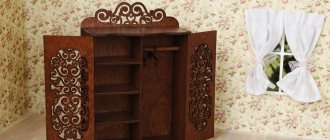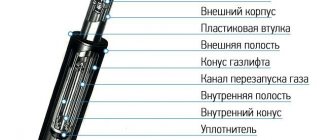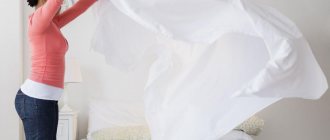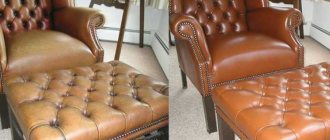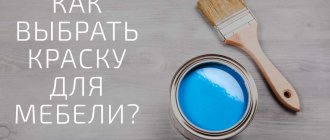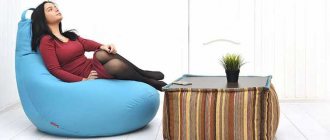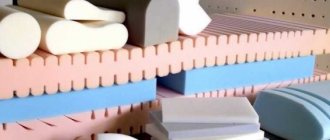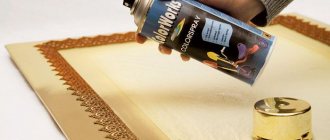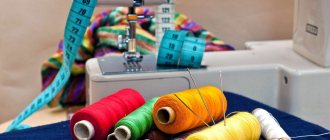The times when straw or down were used for mattresses have already passed, but now instead of them foam rubber is chosen - a material that is distinguished by its availability and different characteristics, which allows you to choose the filler that will fully satisfy all your wishes and ensure a comfortable sleep.
We create a comfortable mattress ourselves
Having decided to create an orthopedic mattress with your own hands, you need to consider a number of points.
- Qualities. Making a mattress with your own hands is quite possible. It can even be exciting. However, if you intend to get a quality product, you cannot do without accuracy, perseverance, patience and scrupulousness.
- Theory. If you only have the desire, but no special skills or even theoretical knowledge, it would not hurt to read several articles about the types of modern fillers and their properties, the required degree of mattress hardness and the materials used for sewing covers.
- Materials. The search for the materials themselves - blocks or layers of filler, special glue and fabric for covering - is a crucial moment. The degree of difficulty in finding high-quality, durable and safe materials will depend on the region in which you live. A big city means great opportunities, where there is an abundance of assortment. Residents of small towns and villages will have to spend time searching for a reputable manufacturer on the Internet and pay extra for delivery.
- Tools. Next, you will need to ensure that you have the necessary tools for the job.
- Case. If you don’t know how to sew, you need to think about someone who can help you calculate the amount of fabric for the cover and can make it.
If you have high-quality materials and a careful approach to business, you can count on quite good results!
Manufacturing technology
After we have prepared all the necessary materials and tools, we can begin to work.
The star of the series “Sultan of My Heart” spoke about the choice of his future wife
Seven daily habits of happy people
The newlyweds traveled all over the world and took wedding photos in every country
- First of all, take a tape measure and measure the bed, and then take all the necessary measurements for the future mattress.
- In order to make a frame, make a special box. It will prevent the structure from moving back and forth. The thickness of the box itself should vary from five to ten centimeters. We make a box in the form of a rectangle and glue the joints together using special glue.
- And now you need to put the filler itself in the box. If you managed to buy a solid filler, then simply make it the required size and insert it into the box. If you are lucky enough to buy the pieces, then insert the pieces into the frame. Foam rubber should be ten to fifteen centimeters thick.
- If you want to combine different types of fillers, it will be much more difficult for you at this stage of the work. If you want to avoid the mattress rolling back and forth on the surface, it is better to glue the layers of foam rubber together well.
- If you want to use thin rubberized foam, you will simply have a hard time finding it on sale. If you find one, its thickness should be no more than five centimeters.
It is better to make the base from solid elements rather than from pieces.
DIY foam mattress
Foam rubber (polyurethane foam) is a material ideal for beginners. To create a monoblock foam mattress, you need a minimum knowledge of the technological process and a minimum amount of materials for its creation. In addition, PPU blocks are a relatively affordable product. It is possible to select the block size, desired height, density and hardness.
Selection of foam rubber for a mattress (foam rubber density)
In the modern production of orthopedic mattresses, foam rubber, or as it is also called, polyurethane foam (PPU), is the main filler that ensures the comfort and durability of sleep products. In spring models it insulates the spring block, in springless models it performs load-bearing functions.
Thanks to scientific and technological progress and new technologies, the properties of foam rubber have been significantly improved in recent years. Now this is not the same at all: crumbling, yellowing, quickly losing elasticity, sticking together material, and improved - in some brands literally beyond recognition.
Reference! Foam rubber is soft, elastic polyurethane foam (PPU). The name foam rubber is nothing more than the transition of the name of the trademark (the Norwegian company Porolon, which supplied polyurethane foam to the USSR in Soviet times) into a common noun.
Brands of furniture foam rubber are conventionally divided into 6 categories. PPU marking reads as:
- letters at the beginning - brand of foam rubber;
- the first two digits are the density of the material (kg/m³);
- the second two numbers are stiffness (compression resistance).
Soft (HS) - not recommended for mattresses.
Standard (ST) , made from a single polyol. The stiffness of a material is determined by its density. Density 35 (ST 3542) is considered suitable for mattresses in the ST category.
Reference! Even with a density of 35 ST, it is not designed for people with heavy weight (optimally up to 80 kg).
Increased rigidity (EL) - reinforced, reinforced polyurethane foam, with the addition of rigidity to the standard polyol. Thanks to this, at the same density, a more rigid material is obtained. An excellent option for a quality mattress is the EL 3245 brand.
Extra hard (HL) . For example, HL 4065 is a brand with high density and rigidity. Durable, reliable, expensive foam rubber for mega-springless, designed to withstand extreme loads in the form of pressure from the weight of very fat people.
Highly elastic (HR) is made from four polyols. The production process is quite labor-intensive, which consequently affects the price. Durable, with greater load-bearing capacity. HR 5535 is a brand that deserves attention - with a service life of up to 15 years.
Reference! Brand HR* 6030 LL - WATERLATTEX - highly elastic, with increased comfort. It feels almost impossible to notice the difference between waterlatex and natural latex.
Viscoelastic (VE) - MEMORY is the latest product in the production of polyurethane foams. Expensive, but the material completely justifies the price. It is considered one of the best due to durability, reliability, quality, and high anatomical effect. The EL 5020 brand has proven itself to be excellent.
Advice! Before you decide to purchase the VE brand, test the properties of the material by lying on it. Although in most cases reviews of the characteristics are enthusiastic, not all 100% of those who have tried it like the enveloping effect.
Preparation of materials and tools
You will need:
- High-hardness foam rubber (HL) with a thickness of at least 5 cm - for the mattress frame (around the perimeter). In the case when a mattress for a full person is made of HL brand foam rubber, there is no need to make an additional frame. Ready-made mattresses in the line for overweight people are equipped with a European frame.
- The main filler is one of the following brands: EL, HR, HR*, VE. The budget HS brand is not recommended at all for making mattresses. The ST brand is suitable for an item that will be rarely used, such as a guest place, a country house option.
- Layers of coconut coir - optional. As layers (to increase rigidity) or on top of one side of the mattress (to create a product with double-sided rigidity).
- Roulette.
- Marker or felt-tip pen - for marking.
- A long ruler or staff - for drawing straight lines.
- A sharp knife is for cutting foam rubber.
- A sheet of plywood - as a backing for the cut.
- Special glue for gluing foam rubber (you can consult it at a furniture store or on a website selling polyurethane foam).
- The fabric for sewing the cover is preferably specialized. This can be jacquard, a quilted version with a softening backing or insulation, bamboo fiber, terry with a waterproof membrane base.
- Long zipper (or 2 shorter ones), threads.
- Scissors - for cutting the cover.
- Sewing machine.
Making a mattress
Below are step-by-step instructions for making the simplest model of a mattress from a PU foam block.
- To begin, take accurate internal measurements of the bed frame.
- Then they cut out strips of extra-hard polyurethane foam for the frame of the mattress. The height of the strips is equal to the future height (thickness) of the mattress. A rectangle assembled from strips along the outer perimeter must correspond to the internal dimensions of the bed frame.
Reference! How is polyurethane foam cut? First, mark with a felt-tip pen or marker. A sheet of plywood is placed under the cut site so as not to damage the surface on which the cut is being made. You need a very sharp knife, preferably with a replaceable blade (otherwise you will have to constantly sharpen it). The knife is held vertically, movements must be precise and strong. If the thickness of the foam rubber is greater than the length of the knife blade, the foam rubber is cut to the thickness of the length of the blade, then spread apart and moved deeper, again holding the knife vertically. The appearance of scratches on the foam rubber is a signal that the blade needs to be changed or sharpened.
- The strip bars are glued together by laying them on a flat surface.
- A precisely cut base from a polyurethane foam block of lower rigidity is placed inside the frame. The ends of the mattress are glued to the inner sides of the foam frame box.
Important! The base block must be solid.
If desired, one side of the mattress can be equipped with a slab of latex coir, gluing it to the surface!
How to sew a mattress cover?
To sew a cover you will need:
- Take accurate measurements of the finished mattress: length, width, height (thickness).
- Calculate the amount of fabric based on the size of the mattress and the width of the fabric sample you like.
- Cut out two rectangles (top + bottom) with seam allowances for sewing the side strip along all four edges.
- Cut a strip around the sides of the mattress. It would be better if the cover was removable. To do this, the strip encircling the sides of the mattress is cut along the middle. On one side (long or short) it is stitched tightly. The remaining three are connected using a long zipper (or two) sewn in - similar to the principle of a suitcase fastener. In the version with a zipper, it is important not to forget to give additional allowances for attaching the zipper.
Important! The cover should be very thick - so thick that you have to put it on with outside help, but not too small.
Types of foam rubber
Most homemade mattresses are made from foam rubber, and when choosing this material, you need to take into account its type.
Foam rubber comes in the following types:
- Soft (HS marking) – not recommended when making a mattress, as it will not provide support for the body on its surface and the person will “sink” on it;
- Standard (ST). Mainly used for children's products and characterized by a density of 25 kg/m3.
- Increased hardness (EL). The most optimal option for a mattress, can withstand loads of up to 100 kg. There are several varieties of such foam rubber, the service life of which is from 5 to 10 years;
- Extra hard (HL). This type has a higher density and rigidity and is suitable for people with greater weight;
- Highly elastic (HR and VE) is the most expensive option, characterized by increased strength, durability and anatomical effect.
When choosing foam rubber, you need to pay attention to its marking, which serves as a guide and contains the characteristics of the material. It looks like this - ST 3542, where the first 2 letters indicate the brand of foam rubber (their list is given above), the first 2 digits indicate density, the last 2 digits indicate compression resistance (hardness).
Foam rubber is the main material that is needed to make a mattress yourself, but in addition to it, you will also need additional materials and tools.
How to sew a mattress cover?
Mattress cover. The principle of sewing a mattress cover is similar to the algorithm for sewing a mattress cover. The difference is that a mattress pad does not have to fit as tightly around the mattress as a cover does.
With corner elastic bands. You can limit yourself to sewing a simplified thick mattress cover-dust cover with corner elastic bands.
With elastic around the perimeter. Another simple model: a mattress cover with sides, held in place by an elastic band pulled into the drawstring (along the perimeter).
How to make a mattress smaller at home?
If for some reason the finished mattress cannot be returned, but needs to be reduced in size (shortened, narrowed), you will need to perform 5 simple steps.
- Undo the sheathing on the desired side.
- Use a marker and a long strip to mark.
- Cut off the springless block (if necessary, disconnect part of the spring block).
- Shorten (narrow) the sheathing accordingly.
- Carefully sew up the cover.
How to make a mattress harder or softer?
A topper is a thin mattress - a product that helps correct hardness. Models made of latex, soft polyurethane foam or holofiber will add softness to the sleeping surface. Latexed coir is a hard filler.
Reference! Like a mattress, you can make your own topper.
Coconut mattress cover - a way out
A real salvation for those who have decided to make their mattress harder is a mattress topper with a layer of coconut coir. This natural filler gives the new cover attached to the old mattress additional elasticity and firmness. Most often, latex coir is used - a material in which the main component in the form of coconut fiber is impregnated with latex. We recommend Askona mattress covers.
In addition to increasing the orthopedic effect, the coconut mattress cover has many other advantages:
- does not absorb moisture and does not rot,
- does not deform (subject to operating rules);
- is perfectly ventilated, helping the mattress “breathe”;
- does not cause allergies;
- is not a breeding ground for microorganisms and insects;
- has a high degree of strength and reliability.
The characteristics of the mattress cover have a general beneficial effect on the body of a sleeping person . His spine takes the correct anatomical position, the muscles relax, and the load on all parts of the body is distributed evenly.
It is not recommended to bend mattress covers and mattresses based on coconut coir, so as not to break the natural fibers.
If you weigh no more than 90 kg, then a coconut mattress cover with a thickness of no more than 3 cm will be sufficient. If you weigh more, then take a closer look at thicker models up to 6 cm in height.
Summing up
As you can see, making a mattress with your own hands is quite a feasible task. What is needed for this?
- The desire to see things through to the end and a determined attitude.
- Determination of needs (size, height, desired degree of rigidity).
- A little theoretical knowledge (about the types of fillers, adhesives, fabrics for covering).
- Availability of quality materials.
- Accuracy in work, precision of movements, patience, perseverance.
- The cover and mattress cover can be sewn yourself or to order.
